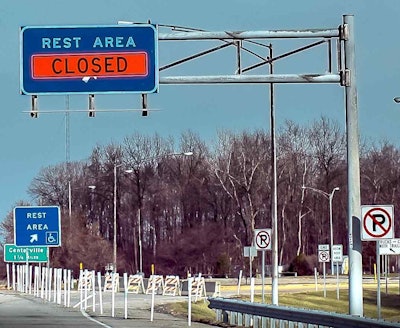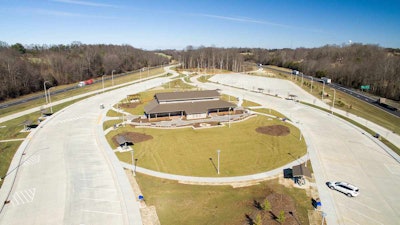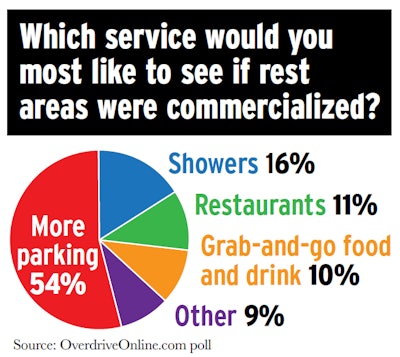Previously in this series: The extent of expanded paid parking reservations after the ELD mandate
 A combination of factors, including a lack of funding and aging facilities in need of renovations or complete rebuilds, is closing or threatening to close rest areas in some parts of the country.
A combination of factors, including a lack of funding and aging facilities in need of renovations or complete rebuilds, is closing or threatening to close rest areas in some parts of the country.For years, states have closed rest areas temporarily or permanently as budget-cutting measures during funding crises. These continuing closures pose further setbacks to the availability of truck parking.
The problem is worsened by the scheduling pressures created by the electronic logging device mandate. Consequently, when President Trump’s infrastructure bill was introduced in February, midway through the ELD mandate’s soft enforcement period, its call for giving states the ability to commercialize rest areas and profit from them carried more import than past efforts at rest stop commercialization.
Rest areas built in the 1950s or earlier, as well as service plazas along toll roads, can offer commercial services. By law, rest areas built after 1960 can sell only vending machine items. The ability to commercialize these rest stops would give states the ability to add restaurants, fueling and maybe even additional parking.
Connecticut is an example of a parking crisis that’s liable to get much worse. A study showed the state needs at least 1,200 more truck parking spaces each night, says Connecticut Department of Transportation spokesperson Kevin Nursick. Yet the state is considering closure of its seven rest areas in July, with a total 222 truck parking spaces.
After budget cuts in 2016, Nursick says, the state DOT had to “curtail, eliminate, cut and postpone roughly $5 billion in projects.” That included shrinking operating hours for the rest areas from 24 to eight. After hours, portable toilets now take the place of restrooms.
Commercialization proponents envision a much more prosperous future for rest areas. “Our 57 rest areas see approximately 26 million people a year,” says Jimmy Parrish, rest area section supervisor for the North Carolina DOT. “If each of those people spent just $1, that would be $26 million. That would generate enough money to where it would pay for maintenance, construction of new facilities and renovation of existing facilities.”
 North Carolina recently
North Carolina recentlyclosed four outdated rest areas along I-77 to facilitate the opening of a new rest area in the median of I-77 just north of Statesville. The new rest area is the first in the state to be built in the median and accessible by both sides of the interstate. The closings and the one opening resulted in a net loss of just one truck parking space.
Of those 57 rest areas, 38 are on interstates. Parrish says the state spends just under $10 million each year to operate its rest areas. If commercialization were legalized, he says, the easiest thing to add would be food services. Adding fuel services would be more difficult due to fuel tank permitting. With planning, more truck parking could be added.
 At a glance, it might seem that truckers would be happy if rest areas offered more parking and commercial services than they do now. That’s not necessarily the case, because there’s no guarantee that commercialized rest areas would avoid the truck stop trend of charging for some parking spots. Jeff Kent, of Pryor, Oklahoma, foresees a pay-to-park structure, at least for long-term parking, at commercialized rest areas, along with other higher-priced amenities. At the same time, he says that if commercialization is the only way rest stops can stay open, he’d rather have that than see the majority close. His main use of rest areas is “to take my 30-minute break.”
At a glance, it might seem that truckers would be happy if rest areas offered more parking and commercial services than they do now. That’s not necessarily the case, because there’s no guarantee that commercialized rest areas would avoid the truck stop trend of charging for some parking spots. Jeff Kent, of Pryor, Oklahoma, foresees a pay-to-park structure, at least for long-term parking, at commercialized rest areas, along with other higher-priced amenities. At the same time, he says that if commercialization is the only way rest stops can stay open, he’d rather have that than see the majority close. His main use of rest areas is “to take my 30-minute break.”Parrish says a road-widening project on I-26 south of Asheville will include the demolition of two rest areas. The rebuilds will increase truck parking at each location from 11 to 35 spaces without the state buying more land. “If the money is there from commercialization, we could do a lot to help with truck parking on existing sites just by reconfiguration.”
Having met with other states’ rest area and DOT managers at the National Safety Rest Area Conference, Parrish believes many states would support commercializing rest areas because of the new funding stream.
NATSO, representing truck stop operators, and the National League of Cities issued a joint press release in March urging lawmakers to reject rest area commercialization. The groups say it would threaten truck stops and other private businesses.
NATSO also claims that the older rest areas able to sell food and fuel have “stifled business growth” at nearby interstate exits. The group claims that in counties with commercial rest areas, there are 56 percent fewer restaurants, convenience stores and truck stops versus comparable counties.
The infrastructure package, if approved as-is by Congress, would require rest area profits to be reinvested in the corridor in which they are generated to support new infrastructure investment. It also specifically notes that states would not be allowed to charge for “essential services” such as water and restroom access. It doesn’t mention truck parking among those services.
Trump said in March that any congressional action on an infrastructure plan likely would come after the 2018 midterm elections.
Next in this series: Providing real-time counts of parking spaces










